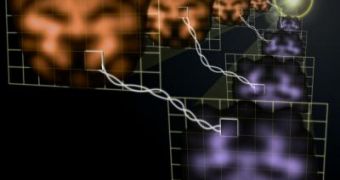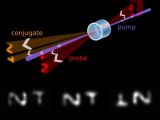Researchers from the Joint Quantum Institute of the Commerce Department's National Institute of Standards and Technology have created quantum images for the first time by making use of a convenient and flexible method of creating twin laser beams. Quantum images are entangled visual patterns capable of storing vast amounts of information that may one day be used to help detect faint images or even store, process and transmit large amounts of highly secure encrypted information.
"Images have always been a preferred method of communication because they carry so much information in their details. Up to now, however, cameras and other optical detectors have largely ignored a lot of useful information in images. By taking advantage of the quantum-mechanical aspects of images, we can improve applications ranging from taking pictures of hard-to-see objects to storing data in futuristic quantum computers", says Vincent Boyer, leader of the study.
In conventional photography images are stored only as a combination of information regarding the color and light intensity. Alternatively, holograms can also record the phase of the light. But these are not the only properties defining a wave of light, since quantum mechanics also determine random fluctuations in the light intensity, which are expressed in the form of variations in properties. Practically, these random uncertainties are a type of noise, but by controlling them researchers could amplify images and even position laser beams with greater accuracy.
The noise cannot be totally suppressed because it is of quantum mechanics nature and, as previously said, it appears randomly; however, it is possible to reduce its effects. One of the techniques used to reduce noise is light squeezing, which targets the minimization of the effects of noise in one of the properties of light while increasing it in the others.
The quantum images produced at NIST are transmitted from twin laser beams that originate from the same point in space, but have been separated and entangled, meaning that their properties are linked with each other. Since they have been squeezed, the noise determined by random fluctuations is minimized when the images are matched, enabling them to carry much more information than any other conventional image.
During the experiment, the researchers used a method known as the 'four-wave mixing', where light enters a gas to produce an outgoing light wave that is then passed through a stencil and is imprinted with the image. After the image has been encoded, the light beam is joined with a pump beam inside a rubidium gas cell, thus amplifying the original image. At the same time a second image is emitted by the atoms, an identical copy of the first except rotated by 180 degrees and of a different color.
The greatest achievement of the new experiment is that each image contains up to 100 distinct regions (pixels) that complement each other. Since the pixels are entangled, their random fluctuations are similar and the properties of one can be used to predict those of the other.
"Making entangled quantum images is really striking, but what is most impressive to us is that the technique for making them is so much easier than what was possible before", says Paul Lett of the Joint Quantum Institute.
Previous similar experiments involved creating quantum images through 'photon counting', which meant collecting one photon at a time, or constructing highly specialized images. The new method however, can create a much wider variety of images in short amounts of time.

 14 DAY TRIAL //
14 DAY TRIAL // 
